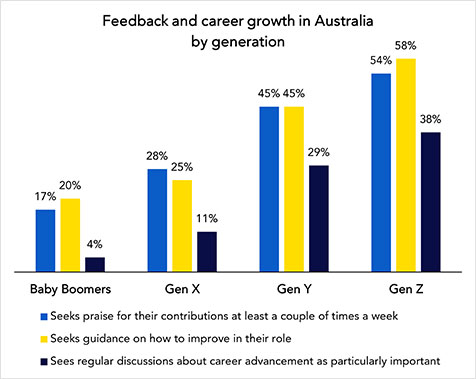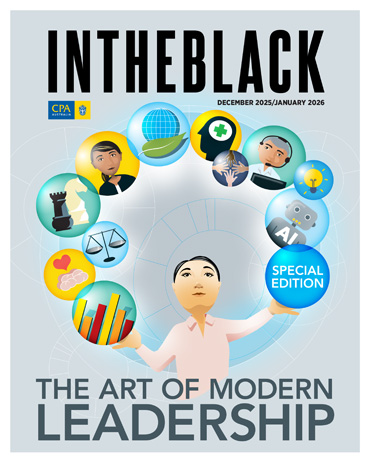Loading component...
At a glance
By Beth Wallace
Offering employees feedback on their performance is a long-standing practice and an essential leadership skill. Research reveals workers have a strong appetite for it, too – particularly younger generations.

An Australian McCrindle study found that 58 per cent of Gen Z workers seek guidance on how to improve in their roles, compared to 45 per cent of Gen Y, 25 per cent of Gen X and 20 per cent of Baby Boomers.
Yet management thinker Marshall Goldsmith believes there is a fundamental problem with the notion of feedback because it focuses on what has already occurred, rather than opportunities for the future.
Instead, Goldsmith suggests “feedforward” as a more valuable alternative.
What is feedforward?
Goldsmith describes feedforward as the counterpoint to feedback. While feedback is composed of opinions on past behaviour, “feedforward represents other people’s ideas that you should be using in the future”.
Deanne Boules, founder and chief enabling officer at Insync Workplace Solutions, says feedforward is an excellent strategy for managers to use with employees, because it focuses on future performance and improvement rather than critiquing past actions.
“Unlike feedback, which often looks back at what went wrong or right and can put people into a threat state, feedforward encourages individuals to think proactively about how to enhance their future efforts,” she explains.
"Ultimately, we’re giving feedforward or feedback because we want to motivate and inspire somebody to be better and we want to get better results for our clients and for our workplaces. But when we don’t give examples and don’t let them know that it is a two-way conversation, it is disengaging and unhelpful."
“This approach is particularly beneficial in a managerial context because it promotes a positive atmosphere and focuses on development and growth potential.”
Rather than replacing feedback, feedforward complements it, Boules adds, explaining that it is “especially motivating for team members who may be discouraged by negative feedback”.
Feedforward can also be used alongside traditional career conversations, which might broadly address an employee’s aspirations, strengths, weaknesses and development opportunities within the company.
Here are seven principles to get the most out of feedforward.
1. Get comfortable with discomfort
Georgia Murch, founder of Can We Talk and a bestselling author in the feedback, culture and personal development space, believes feedforward has gained traction in recent years because people have grown reluctant to give feedback for fear of how the recipient might respond.
“It is fear of conflict, fear of damaging the relationship, fear of their emotional reaction, fear of getting it wrong, fear of not being liked and fear of consequences,” Murch explains.
“But I think we need to get comfortable with discomfort – to shift from a ‘nice’ culture to a ‘kind’ culture, in which whenever there are conversations about somebody’s growth or development, you can put the other person as the priority, not your own discomfort.”
Murch cautions that feedforward is different to feedback because it allows managers to give advice about what they want to see in the future but does not necessarily acknowledge that there is an issue in the first place. This ties back to managers needing to overcome the discomfort of giving employees feedback about gaps.
2. Establish positive intent and content
A crucial step when sharing any kind of advice or observations, Murch says, is to communicate positive content and intent. Content means real-life examples and facts, rather than opinion statements or assumptions, that the instigator should use to justify the conversation. Meanwhile, intent is “being interested in the other person’s truth as much as sharing your own”.
“It is not about giving advice,” she adds. “That’s done when we both agree on the problem or situation.
"Unlike feedback, which often looks back at what went wrong or right and can put people into a threat state, feedforward encourages individuals to think proactively about how to enhance their future efforts."
“People hear your content but smell your intent. Your intent is how committed you are to hearing their perspective. People can smell if you want to dump and run or are really interested in another’s truth – not just your own.
“Ultimately, we’re giving feedforward or feedback because we want to motivate and inspire somebody to be better and we want to get better results for our clients and for our workplaces.
“But when we don’t give examples and don’t let them know that it is a two-way conversation, it is disengaging and unhelpful,” Murch says.
3. Encourage self-reflection
Boules suggests asking team members to anticipate potential challenges in their upcoming tasks and think about how they might overcome them. This fosters a proactive mindset and prepares them for obstacles.
4. Stay in the moment
For feedback or feedforward to work well, conversations should be had “in the moment”, Murch says, and encourages managers to make time for one-on-one check-ins with employees as and when issues arise, and they identify areas for growth.
“We need to start seeing things and nipping them in the bud,” she stresses. “For example, you might say, ‘I noticed in that meeting you rolled your eyes – talk to me about what that was about’.
“You’re saying you want to know what’s going on for that person, because you care about them doing good work and their brand reputation.”
5. Be specific
When discussing upcoming projects or responsibilities, Boules recommends offering employees specific advice on how to approach these effectively.
For example, if a team member will lead a project, suggest concrete ways to enhance their leadership skills, such as by attending a workshop or shadowing a mentor, Boules says.
6. Focus on solutions
Instead of dwelling on what might go wrong, discuss what success looks like and how to achieve it, Boules says.
For instance, if a team member is working on improving their public speaking, discuss strategies such as practicing with a peer or capturing video rehearsals to critique their performance.
7. Set clear goals
Help employees set achievable goals for the skills or competencies they wish to develop. This could involve setting SMART (Specific, Measurable, Achievable, Relevant, Time-bound) goals for areas they want to improve in, such as enhancing client relationship management skills by initiating monthly check-in calls.
By incorporating these strategies, Boules says managers can use feedforward to not only engage team members but also empower them to grow and succeed in their roles.
She adds, “The emphasis on future potential and continuous improvement can make feedforward a key tool in a manager’s toolkit for driving team performance and morale.”

